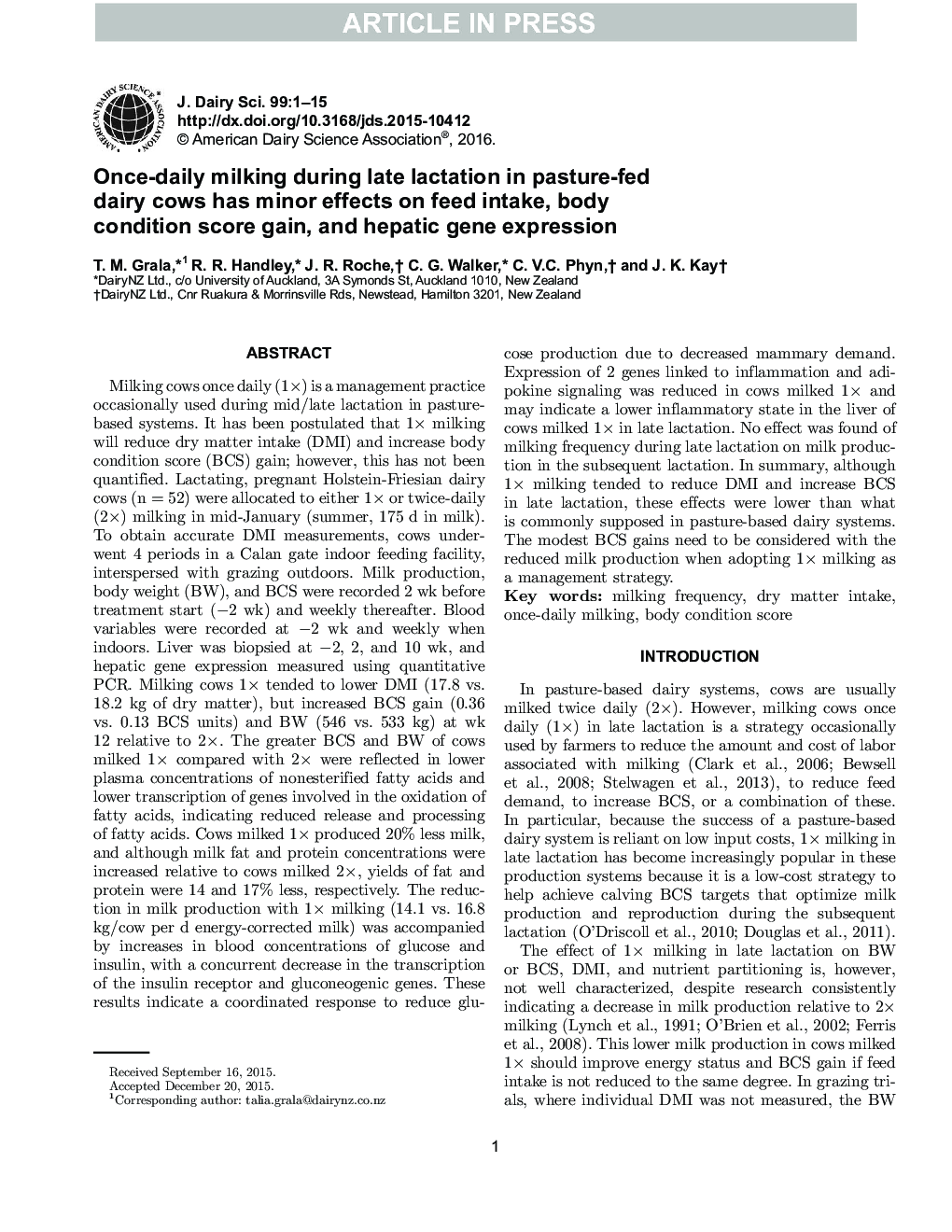| کد مقاله | کد نشریه | سال انتشار | مقاله انگلیسی | نسخه تمام متن |
|---|---|---|---|---|
| 10973128 | 1108010 | 2016 | 15 صفحه PDF | دانلود رایگان |
عنوان انگلیسی مقاله ISI
Once-daily milking during late lactation in pasture-fed dairy cows has minor effects on feed intake, body condition score gain, and hepatic gene expression
ترجمه فارسی عنوان
شیردهی روزانه در طی دیر شیردهی در گاوهای شیرده تغذیه شده با مرتع دارای اثرات جزئی بر میزان مصرف خوراک، افزایش نمره وضعیت بدن و بیان ژن کبدی است
دانلود مقاله + سفارش ترجمه
دانلود مقاله ISI انگلیسی
رایگان برای ایرانیان
کلمات کلیدی
فرکانس شیردوشی، مصرف ماده خشک، دوشش یک بار در روز، نمره وضعیت بدن،
موضوعات مرتبط
علوم زیستی و بیوفناوری
علوم کشاورزی و بیولوژیک
علوم دامی و جانورشناسی
چکیده انگلیسی
Milking cows once daily (1Ã) is a management practice occasionally used during mid/late lactation in pasture-based systems. It has been postulated that 1à milking will reduce dry matter intake (DMI) and increase body condition score (BCS) gain; however, this has not been quantified. Lactating, pregnant Holstein-Friesian dairy cows (n = 52) were allocated to either 1à or twice-daily (2Ã) milking in mid-January (summer, 175 d in milk). To obtain accurate DMI measurements, cows underwent 4 periods in a Calan gate indoor feeding facility, interspersed with grazing outdoors. Milk production, body weight (BW), and BCS were recorded 2 wk before treatment start (â2 wk) and weekly thereafter. Blood variables were recorded at â2 wk and weekly when indoors. Liver was biopsied at â2, 2, and 10 wk, and hepatic gene expression measured using quantitative PCR. Milking cows 1à tended to lower DMI (17.8 vs. 18.2 kg of dry matter), but increased BCS gain (0.36 vs. 0.13 BCS units) and BW (546 vs. 533 kg) at wk 12 relative to 2Ã. The greater BCS and BW of cows milked 1à compared with 2à were reflected in lower plasma concentrations of nonesterified fatty acids and lower transcription of genes involved in the oxidation of fatty acids, indicating reduced release and processing of fatty acids. Cows milked 1à produced 20% less milk, and although milk fat and protein concentrations were increased relative to cows milked 2Ã, yields of fat and protein were 14 and 17% less, respectively. The reduction in milk production with 1à milking (14.1 vs. 16.8 kg/cow per d energy-corrected milk) was accompanied by increases in blood concentrations of glucose and insulin, with a concurrent decrease in the transcription of the insulin receptor and gluconeogenic genes. These results indicate a coordinated response to reduce glucose production due to decreased mammary demand. Expression of 2 genes linked to inflammation and adipokine signaling was reduced in cows milked 1à and may indicate a lower inflammatory state in the liver of cows milked 1à in late lactation. No effect was found of milking frequency during late lactation on milk production in the subsequent lactation. In summary, although 1à milking tended to reduce DMI and increase BCS in late lactation, these effects were lower than what is commonly supposed in pasture-based dairy systems. The modest BCS gains need to be considered with the reduced milk production when adopting 1à milking as a management strategy.
ناشر
Database: Elsevier - ScienceDirect (ساینس دایرکت)
Journal: Journal of Dairy Science - Volume 99, Issue 4, April 2016, Pages 3041-3055
Journal: Journal of Dairy Science - Volume 99, Issue 4, April 2016, Pages 3041-3055
نویسندگان
T.M. Grala, R.R. Handley, J.R. Roche, C.G. Walker, C.V.C. Phyn, J.K. Kay,
